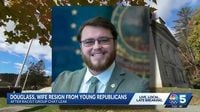On October 29, 2025, the American political landscape was rocked by a scandal that felt all too familiar, yet still managed to provoke widespread outrage. A leaked group chat belonging to the Young Republicans—specifically, the New York State Young Republicans (NYSR)—surfaced online, exposing a torrent of hateful, violent, and bigoted comments from several of the organization’s leadership. The content ranged from casual cruelty and slurs to explicit endorsements of racism, antisemitism, misogyny, and even genocide. The revelations triggered an immediate backlash, but for many observers, the shock was tempered by a sense of weary recognition: this was not an aberration, but the latest chapter in a long and troubling American tradition.
According to reporting by The Alestle, the leaked Telegram chat was not the work of teenagers or fringe actors. Contrary to Vice President JD Vance’s assertion that these were “a bunch of kids in a group chat,” the participants were adults—many occupying leadership positions within the organization. Bobby Walker, then-vice chair of the New York chapter, described rape as “epic.” Peter Giunta, then-chair of the same chapter, threatened those who did not support his leadership bid with “gas chambers,” a chilling reference to Nazi atrocities. William Hendrix, vice chair of the Kansas chapter, reportedly used the “n-word” more than a dozen times. Giunta did issue an apology, stating, “I am so sorry to those offended by the insensitive and inexcusable language found within the more than 28,000 messages of a private group chat that I created during my campaign to lead the Young Republicans. While I take complete responsibility, I have had no way of verifying their accuracy and am deeply concerned that the message logs in question may have been deceptively doctored.”
This defense, however, rang hollow for many. As The Battalion noted, the group chat’s contents were not simply offensive jokes or poor attempts at humor—they were explicit discussions of violence, including NYSR General Counsel Joseph Maligno’s chilling remark about “the best way to kill Jewish people.” The fallout was immediate, with a marked rise in Nazi and white supremacist imagery across the United States. Examples included a University of Georgia student donning a Nazi uniform for Halloween and a U.S. representative displaying an altered American flag with a swastika in his Washington, D.C., office. For many, these incidents served as grim reminders of the real-world consequences of normalizing hateful rhetoric.
The reaction from political leaders was mixed. While some, like New York Representative Elise Stefanik, condemned the hateful messages, others dismissed the scandal as overblown. Vice President JD Vance downplayed the severity, referring to the chats as a “college group chat” and insisting that “people have said much worse things about others.” Instead of focusing on the substance of the Young Republicans’ messages, Vance pivoted to criticize Democrat Jay Jones, a candidate for Virginia’s attorney general, who in a 2022 group chat fantasized about shooting Virginia’s former Speaker of the House Todd Gilbert and his children. Jones’s comments were indeed reprehensible and drew widespread condemnation, but as commentators pointed out, the attempt to draw a false equivalence only served to muddy the waters and deflect accountability.
As Michael Franklin observed in Words Normalize Behavior, the casual cruelty and smirking slurs found in the Young Republicans’ chat echo a much older tradition. The Citizens’ Councils of the 1950s and ’60s—sometimes called the “Uptown Klan”—cultivated a veneer of respectability while defending white supremacy and segregation. These councils sponsored civic education and essay contests for youth, rewarding students for essays arguing that integration was “Communist-inspired” and that segregation was “God’s natural order.” The Young Republicans’ digital group chats, Franklin argues, are simply the latest iteration of this tradition: “High-school essay contests have morphed into encrypted group chats. The platform might be digital now, but the worldview was inherited.”
The parallel extends further. The Citizens’ Councils provided the “respectable” face of bigotry, maintaining social order through policy, while the Ku Klux Klan enforced it through terror. Today, the Young Republicans play the role of the councils, cultivating professionalism and offering platforms to ideas that would once have been unthinkable in polite society. Meanwhile, groups like the Groypers—louder, more openly extremist—embrace fascism, racial purity, and antisemitic conspiracy theories, inspiring several recent mass shooters in states like Colorado, Minnesota, and Tennessee. The relationship is symbiotic: the Groypers shift the boundaries of what is politically acceptable, and the Young Republicans move in to occupy the newly “safe” space.
The digital age has only amplified these dynamics. As The Battalion’s Wyatt Pickering points out, “We live in a world where it’s very easy to say what we want behind a screen. If it’s said in a group chat as a joke, is it okay? Wrong. What we say does matter, and we should never tolerate hateful language from anyone, including the people who claim to be our leaders.” The normalization of hate speech, whether through dog whistles or outright slurs, shapes societal attitudes and can lead directly to discrimination and violence. Even as the First Amendment protects free speech, it does not shield individuals from the social consequences of their words. “The government cannot do or say anything that prevents you from saying awful things, but we as citizens still have the right to call out such behavior and choose not to tolerate such words in our society,” Pickering writes.
The Young Republicans’ scandal is not an isolated incident, but part of a broader pattern. As sociologist Joe Feagin told The Alestle, “It’s chilling, of course, because they will act on these views.” The normalization of hateful language in private spaces inevitably seeps into public life, influencing political culture and, in some cases, inspiring real-world violence. The group chat’s participants themselves seemed aware of the potential consequences—Bobby Walker reportedly warned that if the chat ever leaked, everyone involved would be “cooked.”
Yet, as history shows, the problem is not just the individuals caught saying the quiet part out loud. It is the system that allows, excuses, and sometimes rewards such behavior. The Citizens’ Councils of the past laundered the language of hate, making it bureaucratic and polite. Today’s political youth organizations, Franklin argues, have simply updated the playbook for a digital age, replacing the threat of “race mixing” with coded attacks on “diversity, equity, and inclusion,” and rebranding calls for “law and order” as “stop the steal.” Each phrase serves the same purpose: to cast inclusion as invasion, and cruelty as courage.
Ultimately, the lesson is clear. The architecture of bigotry is not dismantled by ignoring it or dismissing it as the work of a few bad apples. It endures because it is continually rehearsed, repackaged, and defended—sometimes in the name of free speech, sometimes in the name of tradition. The Young Republicans’ group chat should serve as a sobering reminder: when history goes unexamined, its ugliest chapters are doomed to be repeated, sometimes by those who think they are merely joking, and sometimes by those who know exactly what they are doing.
As the dust settles from the latest scandal, the challenge for American society is not just to clutch its pearls, but to confront the enduring legacy of hate—and to finally break the cycle.






